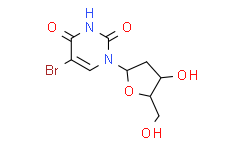| Cas No.: | 59-14-3 |
| Chemical Name: | 5-Bromo-2'-deoxyuridine |
| Synonyms: | 5-Bromo-2'-deoxyuridine;Broxuridine;5'-Bromodeoxyuridine;5-BROMO-1-(2-DEOXY-BETA-D-RIBOFURANOSYL)URACIL;5-BRDU;5-BROMO DEOXYURIDINE;5-BROMO-2'-DESOXYURIDINE;(+)-5-BROMO-2'-DEOXYURIDINE;2'-DEOXY-5-BROMOROURIDINE;2'-DEOXY-5-BROMOURIDINE;5-Bromo-2-deoxyuridine;5-bromo-1-[(2R,4S,5R)-4-hydroxy-5-(hydroxymethyl)oxolan-2-yl]pyrimidine-2,4-dione;5-Bromo-2`-deoxyuridine(BRDU);BROMO-2'-DEOXYURIDINE, 5-(RG);5-Br-2'-Udr;5-BrdU,5-Bromo-1-(2-deoxy-Beta-D-ribofuranosyl)uracil5-Bromouracil deoxyriboside,BUdR;5-Bromo-1-(2-deoxy-Beta-D-ribofuranosyl)uracil5-Bromouracil deoxyriboside;5-Bromodesoxyuridine;5-Bromouracil deoxyriboside;BRDU;BRDU,5-Bromo-2-deoxyuridine;Bromodeoxyuridine;Bromouracil deoxyriboside;BUDR;5-Bromo-1-(2-deoxy-β-D-ribofuranosyl)uracil;BDU;BRDE;5-Bromodeoxyuridine;5-Bdu;Broxuridinum;Broxuridina;5-Bromouracil-2-deoxyriboside;Broxuridinum [INN-Latin];Broxuridina [INN-Spanish];Uridine, 5-bromo-2'-deoxy-;C9H11BrN2O5;Bromoouridine;Radibud;Brudr;5-Budr;5-Bromo-1-(2-deoxy-beta-D-ri |
| SMILES: | BrC1C(N([H])C(N(C=1[H])[C@@]1([H])C([H])([H])[C@@]([H])([C@@]([H])(C([H])([H])O[H])O1)O[H])=O)=O |
| Formula: | C9H11BrN2O5 |
| M.Wt: | 307.0980 |
| Purity: | >98% |
| Sotrage: | 2 years -20°C Powder, 2 weeks 4°C in DMSO, 6 months -80°C in DMSO |
| Description: | 5-BrdU is a nucleoside analog that competes with thymidine for incorporation into DNA. 5-BrdU is commonly used in the detection of proliferating cells. |
| In Vivo: | Bromodeoxyuridine (300 mg/kg, i.p. or 0.8 mg/mL, p.o.) significantly slows tumor progression in rat glioma RG2 tumor model[1]. |
| In Vitro: | Bromodeoxyuridine induces a progressive, dose-responsive suppression of cancer cell line and cancer stem cell population expansion RG2 rat glioma cells. In H9 cells and BJ fibroblasts, bromodeoxyuridine alters the cell cycle profile[1]. BrdU is stably integrated into the DNA, and thus can be used in assessment of cell proliferation and other cell procession[2]. |
| Cell Assay: | Cultures are initially plated at 2000 cells/cm2 and are quantified with a Z2 Coulter Counter. RG2 rat glioma cells are treated once with 0, 1, 10, or 50 µM BrdU for 24 hours, and cumulative growth curves are obtained over 18 days. Control and treated cells are quantified and replated at equal densities on days 5, 12, and 18 after treatment. |
| References: | [1]. Levkoff LH, et al. Bromodeoxyuridine inhibits cancer cell proliferation in vitro and in vivo. Neoplasia. 2008 Aug;10(8):804-16. [2]. Rothaeusler K, et al. Assessment of cell proliferation by 5-bromodeoxyuridine (BrdU) labeling for multicolor flow cytometry. Curr Protoc Cytom. 2007 Apr;Chapter 7:Unit7.31 |

 DC Chemicals' products qualify for U.S. tariff exemptions. We guarantee no price increases due to customs duties and maintain stable supply, continuing to deliver reliable research solutions to our American clients.
DC Chemicals' products qualify for U.S. tariff exemptions. We guarantee no price increases due to customs duties and maintain stable supply, continuing to deliver reliable research solutions to our American clients.





















